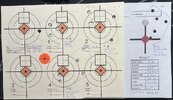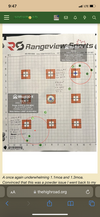Charts and graphs are nice to have but in my world the target is King and honestly and with all due respect those look closer to a scatter node ( anti node) that’s in between a positive node
I didn't see the post with any charts or graphs (maybe they were posted by someone on my ignore list?), but I agree - looking at his targets, I agree it's pretty clear those are either a scatter node, OR clear that the best that combination will shoot just isn't good.
This really feels like one of those examples where we get lost in the idea of "what shot best during that test?" and get too focused on using that result as a step towards the next step, rather than stepping back and truly being honest with ourselves about the result - sometimes we have to simply realize, "that dog don't hunt" and then move towards a more productive combination. If we have a match bullet over a reasonably well fit powder choice coming out of a custom barrel and punching 1.3moa at 100yrds, that dog don't hunt. We MIGHT turn a few big knobs like changing neck tension or changing powders (aka, hunting with a different dog), or changing bullets, and get that barrel and bullet to shoot, or change bullet and get that barrel and powder to shoot small (again, different dog), but what we're looking at right now isn't solved by the small knob of seating depth.
I really hope none of this is coming off as rude, but there's a lot here that just doesn't make sense. Guys can be snarky about advice from Berger if they want, I guess, but I'm really only trying to offer advice - and I don't think many of us who are shooting small groups and shooting long range REALLY start with 40thou seating depth increments... Maybe if a brand new bullet of completely new design were released, but there's rarely anything new under the sun - SOMEONE has shot the bullets were talking about before we get to them, so we can find info about where we should expect them to shoot well, and in the rare instances when they don't, it might be worth asking ourselves WHY? Maybe there's something else wrong which isn't related to seating depth at all? And frankly, we do learn more every year as more and more of us test, prove, and disprove more and more theories. Records get broken every year, new revelations of ballistic experience (aka science, the study of shooting real bullets at real targets) are earned every year - take Berger's own VLD article as an example, for years they gave advice to seat VLD's jammed or very near the lands, because that's what worked, then enough folks tried jumping them long and had great results that Berger tested it, so they published new information and new advice for seating their VLD bullets:
[quote = "Berger Website: Getting the Best Precision and Accuracy from VLD Bullets"]
For years we encouraged shooters to use a base of cartridge to end of bearing surface OAL (I will use the term COAL to represent this dimension) which allows the VLD to touch the rifling or to be jammed in the rifling. This provided excellent results for many shooters but there were others who did not achieve top performance with the VLD jammed in their rifling. These shooters were left with the belief that the VLD bullets just won’t shoot in their rifle.
[...]It was not until the VLD became very popular as a game hunting bullet that we were then able to learn the truth about getting the VLD bullets to shoot well in a large majority of rifles.
After we proved that the Berger VLD bullets are consistently and exceptionally capable of putting game down quickly we started promoting the VLD to hunters. We were nervous at first as we believe the VLD needed to be in the rifling to shoot well and we also knew that most hunters use a magazine and SAMMI chambers. Our ears were wide open as the feedback was received. It was surprising to hear that most shooters described precision results by saying “this is the best my rifle has ever shot.”
We scratched our heads about this for awhile until we started getting feedback from hunters who were competition shooters as well. Many were the same guys who were telling us for years that the VLDs shoot great when jumped. Since a much larger number of shooters were using the VLD bullets with a jump we started comparing all the feedback and have discovered the common characteristics in successful reports which gave us the information needed to get VLD working in your rifle. [...]
Solution
[...]What has been discovered is that VLD bullets shoot best when loaded to a COAL that puts the bullet in a “sweet spot”. This sweet spot is a band .030 to .040 wide and is located anywhere between jamming the bullets into the lands and .150 jump off the lands.[/quote]
So the advice which was once "Always jam in the lands to get the VLD to shoot" basically was updated to be, "eh, you'll find a sweet spot the size of Kansas somewhere in the middle of the United States..." Berger discovered that life was a lot easier than they originally believed. That's not to say that jamming VLD's doesn't yield great results, but it finally acknowledges that there's likely a HUGE spectrum of things which could and will shoot well.
We're finding out more and more that load development isn't a process of finding a needle in a haystack, but rather it's more like picking a needle out of a stack of needles we know how to make.






